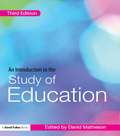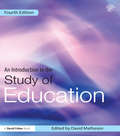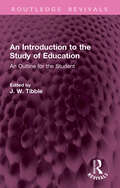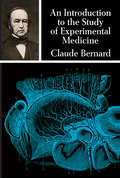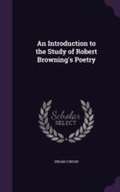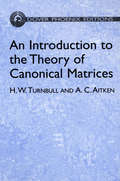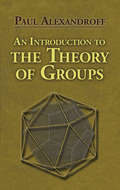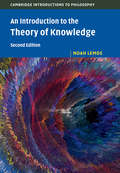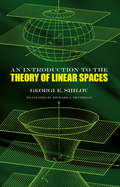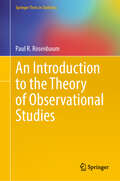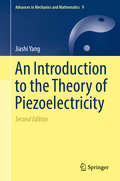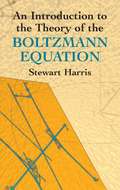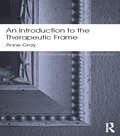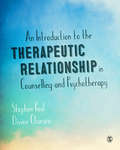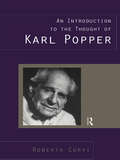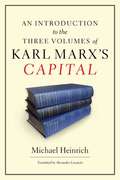- Table View
- List View
An Introduction to the Study of Education
by David MathesonThis fully updated, fourth edition of An Introduction to the Study of Education provides a comprehensive and reflective introduction to the study of education, inviting students to question what education is, who it is for and what purpose it serves. Taking the reader from the early years through to lifelong learning, it examines all forms of education and learning. This new edition includes ten completely new chapters and a step-by-step guide to essay writing. There is also a companion website to accompany the book, featuring additional chapters which can be visited at www.routledge.com/cw/matheson.This fully updated, fourth edition provides: a full exploration of the historical, sociological, philosophical and psychological roots of education; a clear focus on the individual levels of education - preschool, compulsory, post-compulsory and lifelong learning; the latest debates within special educational needs; an in-depth examination of learning styles; insights into the historical development of education and the role of, and background to, research in education; a focus on current educational practice and diversity across the United Kingdom and Ireland. Written in a clear and accessible style, this is the essential core text for all beginning students on undergraduate and postgraduate courses in Education Studies and all those interested in education today, where it came from and where it is going.
An Introduction to the Study of Education
by David MathesonThis fully updated, fourth edition of An Introduction to the Study of Education provides a comprehensive and reflective introduction to the study of education, inviting students to question what education is, who it is for and what purpose it serves. Taking the reader from the early years through to lifelong learning, it examines all forms of education and learning. This new edition includes ten completely new chapters and a step-by-step guide to essay writing. There is also a companion website to accompany the book, featuring additional chapters which can be visited at www.routledge.com/cw/matheson.This fully updated, fourth edition provides: a full exploration of the historical, sociological, philosophical and psychological roots of education; a clear focus on the individual levels of education – preschool, compulsory, post-compulsory and lifelong learning; the latest debates within special educational needs; an in-depth examination of learning styles; insights into the historical development of education and the role of, and background to, research in education; a focus on current educational practice and diversity across the United Kingdom and Ireland. Written in a clear and accessible style, this is the essential core text for all beginning students on undergraduate and postgraduate courses in Education Studies and all those interested in education today, where it came from and where it is going.
An Introduction to the Study of Education: An Outline for the Student (Routledge Revivals)
by J. W. TibbleFirst Published in 1971, An Introduction to the Study of Education is a basic introduction to the curriculum of education which will be of interest to students in colleges of education as well as to sixth formers. The six contributors, all well known in the educational field, consider different aspects of the study of education. J.W. Tibble himself considers the development of the study of education. D.J. Watts contributes a chapter on educational psychology. Anne Dufton looks at the sociology of education, while its history is examined by Malcolm Seaborne and its philosophy by R.F. Dearden. The relationship between theory and practice is considered by Harold Entwistle, and a final chapter, by J.W. Tibble, looks at the curriculum courses available in Britain.
An Introduction to the Study of Experimental Medicine
by Claude BernardClear and penetrating presentation of the basic principles of scientific research from the great French physiologist whose contributions in the 19th century included the discovery of vasomotor nerves; nature of curare and other poisons in human body; functions of pancreatic juice in digestion; elucidation of glycogenic function of the liver.
An Introduction to the Study of Gothic Architecture
by John Henry ParkerThis popular and important textbook of Gothic architecture, first published in 1849, which ran to at least sixteen editions. The book is divided into the main body of the text, with mostly English examples of the various periods, and a section on foreign styles (French Gothic, Italian, Spanish, Swiss, Belgian, German).-Print ed.John Henry Parker CB (1 March 1806 – 31 January 1884) was an English archaeologist and writer on architecture and publisher.He was born in London, the son of John Parker, a merchant there. He was educated at Manor House School, Chiswick, and was apprenticed in 1821 to his uncle, the Oxford bookseller Joseph Parker (1774?–1850). He succeeded to his uncle's business in 1832, and ran the firm with great success, the most important of his publications being perhaps the series of the Oxford pocket classics.In 1836 he published his Glossary of terms used in Grecian, Roman, Italian, and Gothic architecture, which, published during the Gothic Revival in England, had considerable influence in extending the movement, and supplied valuable inspiration to young architects. In 1848 he edited the fifth edition of Thomas Rickman's Gothic architecture, and in 1849 he published a handbook based on his earlier volume entitled Introduction to the study of Gothic architecture. The completion of Hudson Turner's Domestic architecture of the Middle Ages next engaged his attention, three volumes being published (1853–60). He published Medieval architecture of Chester in 1858 and Architectural antiquities of the city of Wells in 1866.Parker was one of the chief advocates of the restoration of ecclesiastical buildings. In 1863 he and the Oxford Diocesan Architect G.E. Street revised plans for the restoration of St. Andrew's parish church, Chinnor. Parker also designed the triplet of traceried lancet windows in the chancel of St. Nicholas the Confessor, Forest Hill. His son James Parker (1832 or 1833–1912) also practiced as an architect.
An Introduction to the Study of Industrial Relations
by Dr J RichardsonThis book gives a comprehensive survey of the field of Industrial Relations, focusing on general principles and problems. Illustrations are drawn from the practices adopted in many parts of the world such as Australia, France, Germany and the USA. Contents include chapters on the following:* Personnel Management* Training* Methods of Wage Payment* Job Evaluation* Profit-Sharing and Co-partnership* Trade Unionism* Employers' Organizations* Collective Bargaining* Wage Bases* Equal Opportunities* Conciliation and Arbitration
An Introduction to the Study of Mysticism
by Richard H. Jones2022 CHOICE Outstanding Academic TitleThe purpose of this book is to fill a gap in contemporary mystical studies: an overview of the basic ways to approach mystical experiences and mysticism. It discusses the problem of definitions of “mystical experiences” and “mysticism” and advances characterizations of “mystical experiences” in terms of certain altered states of consciousness and “mysticism” in terms of encompassing ways of life centered on such experiences and states. Types of mystical experiences, enlightened states, paths, and doctrines are discussed, as is the relation of mystical experiences and mysticism to religions and cultures. The approaches of constructivism, contextualism, essentialism, and perennialism are presented. Themes in the history of the world’s major mystical traditions are set forth. Approaches to mystical phenomena in sociology, psychology, gender studies, and neuroscience are introduced. Basic philosophical issues related to whether mystical experiences are veridical and mystical claims valid, mystics’ problems of language, art, and morality are laid out. Older and newer comparative approaches in religious studies and in Christian theology are discussed, along with postmodernist objections. The intended audience is undergraduates and the general public interested in the general issues related to mysticism.
An Introduction to the Study of Social Administration (Routledge Library Editions: Social Administration & Social Policy)
by David C. MarshOriginally published in 1965, this introductory textbook provides the student with an outline of the subject matter of Social Administration. It deals with the growth of this discipline of study, its inter-relatedness with the other social sciences, and examines the historical development and structure of the social services in the 20th Century. The book discusses the complexity of the study of the study of the formation and implementation of social policy in the United Kingdom and will be of interest to those in the areas of the history of social policy and the welfare state.
An Introduction to the Theory of Canonical Matrices
by H. W. Turnbull A. C. AitkenThorough and self-contained, this penetrating study of the theory of canonical matrices presents a detailed consideration of all the theory's principal features. Topics include elementary transformations and bilinear and quadratic forms; canonical reduction of equivalent matrices; subgroups of the group of equivalent transformations; and rational and classical canonical forms. The final chapters explore several methods of canonical reduction, including those of unitary and orthogonal transformations. 1952 edition. Index. Appendix. Historical notes. Bibliographies. 275 problems.
An Introduction to the Theory of Elasticity
by R. J. Atkin N. FoxThanks to intense research activity in the field of continuum mechanics, the teaching of subjects such as elasticity theory has attained a high degree of clarity and simplicity. This introductory volume offers upper-level undergraduates a perspective based on modern developments that also takes into account the limited mathematical tools they are likely to have at their disposal. It also places special emphasis on areas that students often find difficult upon first encounter. An Introduction to the Theory of Elasticity provides an accessible guide to the subject in a form that will instill a firm foundation for more advanced study.The topics covered include a general discussion of deformation and stress, the derivation of the equations of finite elasticity with some exact solutions, and the formulation of infinitesimal elasticity with application to some two- and three-dimensional static problems and elastic waves. Answers to examples appear at the end of the book.
An Introduction to the Theory of Groups (Dover Books on Mathematics)
by Paul Alexandroff Hazel Perfect G. M. PetersenThis introductory exposition of group theory by an eminent Russian mathematician is particularly suited to undergraduates, developing material of fundamental importance in a clear and rigorous fashion. The treatment is also useful as a review for more advanced students with some background in group theory. Beginning with introductory examples of the group concept, the text advances to considerations of groups of permutations, isomorphism, cyclic subgroups, simple groups of movements, invariant subgroups, and partitioning of groups. An appendix provides elementary concepts from set theory. A wealth of simple examples, primarily geometrical, illustrate the primary concepts. Exercises at the end of each chapter provide additional reinforcement.
An Introduction to the Theory of Knowledge
by Noah LemosA clear and accessible introduction to epistemology or the theory of knowledge.
An Introduction to the Theory of Knowledge (Cambridge Introductions to Philosophy)
by Noah LemosNow revised and containing three new chapters, this book provides a clear and accessible introduction to epistemology, or the theory of knowledge. It discusses some of the main theories of justification, including foundationalism, coherentism, reliabilism, and virtue epistemology. Other topics include the Gettier problem, internalism and externalism, skepticism, the problem of epistemic circularity, a priori knowledge, naturalized epistemology, and the epistemic significance of testimony and disagreement. Intended primarily for students taking their first classes in epistemology, this lucid and well-written text will provide an excellent introduction to anyone interested in knowing more about this important area of philosophy.
An Introduction to the Theory of Linear Spaces (Dover Books on Mathematics)
by Richard A. Silverman Georgi E. ShilovThis introduction to linear algebra and functional analysis offers a clear expository treatment, viewing algebra, geometry, and analysis as parts of an integrated whole rather than separate subjects. All abstract ideas receive a high degree of motivation, and numerous examples illustrate many different fields of mathematics. Abundant problems include hints or answers.
An Introduction to the Theory of Observational Studies (Springer Texts in Statistics)
by Paul R. RosenbaumThis book is an introduction to the theory of causal inference in observational studies. An observational study draws inferences about the effects caused by treatments or preventable exposures when randomized experimentation is unethical or infeasible. An observational study is distinguished from an experiment by the problems that follow from the absence of randomized assignment of individuals to treatments. Observational studies are common in most fields that study the effects of treatments or policies on people, including public health and epidemiology, economics and public policy, medicine and clinical psychology, and criminology and empirical legal studies. After Part I reviews causal inference in randomized experiments, the twelve short chapters in Parts II, III and IV introduce modern topics: the propensity score, ignorable treatment assignment, the principal unobserved covariate, algorithms for optimal matching, randomized reassignment techniques for appraising the covariate balance achieved by matching, covariance adjustment, sensitivity analysis, design sensitivity, ways to design an observational study to be insensitive to larger unmeasured biases, the large sample efficiency of a sensitivity analysis, quasi-experimental devices that provide observable information about unmeasured biases, evidence factors and complementary analyses to address unmeasured biases. The book is accessible to anyone who has completed an undergraduate course in mathematical statistics. The subject is developed with the aid of two simple empirical examples concerning the health benefits or harms caused by consuming alcohol. The data for these examples and their reanalyses are freely available in an R package, iTOS, associated with Introduction to the Theory of Observational Studies.
An Introduction to the Theory of Piezoelectricity (Advances in Mechanics and Mathematics #9)
by Jiashi YangThis textbook introduces theoretical piezoelectricity. The second edition updates a classical, seminal reference on a fundamental topic that is addressed in every materials science curriculum. It presents a concise treatment of the basic theoretical aspects of continuum modeling of electroelastic interactions in solids. The general nonlinear theory for large deformations and strong fields is established and specialized to the linear theory for small deformations and weak fields, i.e., the theory of piezoelectricity. Relatively simple and useful solutions of many static and dynamic problems of piezoelectricity that are useful in device applications are given. Emphasis is on the formulation of solutions to problems rather than advanced mathematical solution techniques. This book includes many examples to assist and enhance students’ understanding of piezoelectricity and piezoelastics.
An Introduction to the Theory of Reproducing Kernel Hilbert Spaces
by Vern I. Paulsen Mrinal RaghupathiReproducing kernel Hilbert spaces have developed into an important tool in many areas, especially statistics and machine learning, and they play a valuable role in complex analysis, probability, group representation theory, and the theory of integral operators. This unique text offers a unified overview of the topic, providing detailed examples of applications, as well as covering the fundamental underlying theory, including chapters on interpolation and approximation, Cholesky and Schur operations on kernels, and vector-valued spaces. Self-contained and accessibly written, with exercises at the end of each chapter, this unrivalled treatment of the topic serves as an ideal introduction for graduate students across mathematics, computer science, and engineering, as well as a useful reference for researchers working in functional analysis or its applications.
An Introduction to the Theory of Stellar Structure and Evolution
by Dina PrialnikUsing fundamental physics, the theory of stellar structure and evolution is able to predict how stars are born, how their complex internal structure changes, what nuclear fuel they burn, and what their ultimate fate is - a fading whitedwarf, or a cataclysmic explosion as a supernova, leaving behind a collapsed neutron star or black hole. This lucid textbook provides students with a clear and pedagogical introduction to the theory of stellar structure and evolution. It requires only basic physics and mathematics learnt in first- and second-year undergraduate studies, and assumes no prior knowledge of astronomy. The unique feature of this book is the emphasis throughout on the basic physical principles governing stellar evolution. Exercises and their full solutions are included to help students test their understanding. This textbook provides a stimulating introduction for undergraduates in astronomy, physics, planetary science and applied mathematics taking a course on the physics of stars.
An Introduction to the Theory of the Boltzmann Equation (Dover Books On Physics Series)
by Stewart HarrisBoltzmann's equation (or Boltzmann-like equations) appears extensively in such disparate fields as laser scattering, solid-state physics, nuclear transport, and beyond the conventional boundaries of physics and engineering, in the fields of cellular proliferation and automobile traffic flow. This introductory graduate-level course for students of physics and engineering offers detailed presentations of the basic modern theory of Boltzmann’s equation, including representative applications using both Boltzmann’s equation and the model Boltzmann equations developed within the text. It emphasizes physical aspects of the theory, and it represents a practical resource for researchers and other professionals. The problems following each chapter are intended as learning examples, and they frequently extend and generalize the text material. Additional editorial features include a historical introduction, references, and subject and author indexes. 1971 edition.
An Introduction to the Therapeutic Frame: Routledge Mental Health Classic Editions (Routledge Mental Health Classic Editions)
by Anne GrayDesigned for psychotherapists and counsellors in training, An Introduction to the Therapeutic Frame clarifies the concept of the frame - the way of working set out in the first meeting between therapist and client. This Classic Edition of the book includes a brand new introduction by the author. Anne Gray, an experienced psychotherapist and teacher, uses lively and extensive case material to show how the frame can both contain feelings and further understanding within the therapeutic relationship. She takes the reader through each stage of therapeutic work, from the first meeting to the final contact, and looks at those aspects of management that beginners often find difficult, such as fee payment, letters and telephone calls, supervision and evaluation. Her practical advice on how to handle these situations will be invaluable to trainees as well as to those involved in their training.
An Introduction to the Therapeutic Relationship in Counselling and Psychotherapy
by Stephen Paul Divine CharuraThe therapeutic relationship is considered to be the most significant factor in achieving positive therapeutic change. As such, it is essential that trainee and practising therapists are able to facilitate a strong working alliance with each of their clients. This book will help them do just that, by offering a practical and evidence-based guide to all aspects of the therapeutic relationship in counselling and psychotherapy. Cross-modal in its approach, this book examines the issues impacting on the therapeutic relationship true to all models of practice. Content covered includes: - The history of the therapeutic relationship - The place of the therapeutic relationship in a range of therapy settings, including IAPT - Concepts and practical skills essential for establishing and maintaining a successful working alliance - The application of the therapeutic relationship to a variety of professional roles in health and social care - Practice issues including potential challenges to the therapeutic relationship, working with diversity and personal and professional development - Research and new developments Using examples, points for reflection and chapter aims and summaries to help consolidate learning, the authors break down the complex and often daunting topic of the therapeutic relationship, making this essential reading for trainee and practising therapists, as well as those working in a wider range of health, social care and helping relationships.
An Introduction to the Therapeutic Relationship in Counselling and Psychotherapy
by Stephen Paul Divine CharuraThe therapeutic relationship is considered to be the most significant factor in achieving positive therapeutic change. As such, it is essential that trainee and practising therapists are able to facilitate a strong working alliance with each of their clients. This book will help them do just that, by offering a practical and evidence-based guide to all aspects of the therapeutic relationship in counselling and psychotherapy. Cross-modal in its approach, this book examines the issues impacting on the therapeutic relationship true to all models of practice. Content covered includes: - The history of the therapeutic relationship - The place of the therapeutic relationship in a range of therapy settings, including IAPT - Concepts and practical skills essential for establishing and maintaining a successful working alliance - The application of the therapeutic relationship to a variety of professional roles in health and social care - Practice issues including potential challenges to the therapeutic relationship, working with diversity and personal and professional development - Research and new developments Using examples, points for reflection and chapter aims and summaries to help consolidate learning, the authors break down the complex and often daunting topic of the therapeutic relationship, making this essential reading for trainee and practising therapists, as well as those working in a wider range of health, social care and helping relationships.
An Introduction to the Thought of Karl Popper
by Roberta CorviThis is a comprehensive introduction to the philosophical and political thought of Karl Popper, now available in English. It is divided into three parts; the first part provides a biography of Popper; the second part looks at his works and recurrent themes, and the third part assesses his critics. It was approved of by Popper himself as a sympathetic and comprehensive study, and will be ideal to meet the increasing demand for a summary introduction to his work.
An Introduction to the Three Volumes of Karl Marx's Capital
by Michael Heinrich Alex LocascioThe global economic crisis and recession that began in 2008 had at least one unexpected outcome: a surge in sales of Karl Marx's Capital. Although mainstream economists and commentators once dismissed Marx's work as outmoded and flawed, some are begrudgingly acknowledging an analysis that sees capitalism as inherently unstable. And of course, there are those, like Michael Heinrich, who have seen the value of Marx all along, and are in a unique position to explain the intricacies of Marx's thought. Heinrich's modern interpretation of Capital is now available to English-speaking readers for the first time. It has gone through nine editions in Germany, is the standard work for Marxist study groups, and is used widely in German universities. The author systematically covers all three volumes of Capital and explains all the basic aspects of Marx's critique of capitalism in a way that is clear and concise. He provides background information on the intellectual and political milieu in which Marx worked, and looks at crucial issues beyond the scope of Capital, such as class struggle, the relationship between capital and the state, accusations of historical determinism, and Marx's understanding of communism. Uniquely, Heinrich emphasizes the monetary character of Marx's work, in addition to the traditional emphasis on the labor theory of value, this highlighting the relevance of Capital to the age of financial explosions and implosions.
